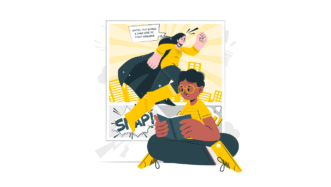LESSON OVERVIEW
This ESL graffiti lesson plan is based on a video which presents the Beyond the Streets exhibition which featured over 100 graffiti artists, and touches upon the history of graffiti and street art. The worksheet includes some vocabulary tasks as well as two listening comprehension activities. Students will also have the possibility of expressing their opinion about this form of art.
C1 / Advanced60 minStandard LessonPremium Plan
VOCABULARY & DISCUSSION
Students start this graffiti lesson plan with a general warm-up discussion about art which includes some reference to street art as well. They have to answer questions and it’s your choice whether it should be an open discussion, a pair work or a group work. Next, they move to a word formation task. They get a few sentences and need to complete them with correct forms of words given in brackets. It includes such words as a curator, an exhibition, soften, etc., and most of them appear in the video they will watch later.
VIDEO – VOCABULARY AND COMPREHENSION
Before watching the video, students need to acquire some vocabulary that may facilitate listening to and understanding speakers from the video. They get four words and phrases in context which they need to match with correct meanings. Then, they move to the first listening comprehension task. In this activity they have to watch the video and answer a few comprehension questions. In the second task, students watch the video again and fill in the gaps in the sentences taken from the video. They need to complete them with one word each.
DISCUSSION
This graffiti lesson plan ends with a discussion. This time students get a list of statement about graffiti and street art and they need to tell whether they agree or disagree with them. Monitor your students and make them use various structures to express their opinions. You can even use our standalone extra worksheet for expressing opinions if you find a need to revise with your students different vocabulary and structures for giving opinions.
Extra Worksheet – Expressing preferences
This extra worksheet supplements our lesson plan on graffiti and includes various words and phrases that more advanced students might use when talking about their preferences. They will of course practise this new language by expressing their opinion on a few works of art we thought people might either love or hate. Discover Love it or hate it worksheet yourself.
WORKSHEETS
Subscribe to unlock these and many other Standalone lesson with the Premium plan
Subscribe














Hi there,
I like this lesson plan and the topic is interesting. I just wondered if it could be better to have the discussion questions before the vocabulary exercise on page 1. Just a thought!
Audrey, thanks for the idea! Actually, when I think about it now, it seems much better to have discussion questions at the beginning of the lesson rather than the word formation task. We’ll definitely change the worksheets 🙂 Thanks!
Another interesting lesson plan. Thanks! I’m going to use it today in class.
There’s a typo in the word “graffiti” in the file name, the header, and the title of this page.
Nat, thanks and tell us how it has worked with your students.
Sorry for typos: virtual facepalm for me!
Looks like a great lesson, unfortunately the link doesn’t work in Australia
Thanks for letting us know about this issue and it’s also nice to hear that people from Australia come to ESL Brains! That’s the farthest from our HQ 🙂 I assume you get a message from YT that this content is unavailable in your country due to copyright issues. If that’s so, we can’t do much about it besides not using content from that channel in the future.
you should have suggested using a vpn 😉
Hi Justa, it worked perfectly! The lesson ran smoothly and both me and my student learned something new about graffiti. 🙂 Thanks a lot!
That’s really great 🙂 happy to hear that!
My students and I enjoyed doing this lesson very much, thank you!
Happy to hear that! Thanks for the comment!
Hi Justa, thank you for the response. I have a few issues with the “interview” sentence. A film star can give an interview to a reporter. A reporter can interview a film star. An interview consists of one person asking another person a series of questions, normally a formal situation that has been pre-arranged (think job/journalist/police interviews). A museum curator cannot give me an interview about modern art. He can answer all my questions about modern art, yes. I could arrange to interview the curator about modern art with a view to publishing the interview, but that’s not the same as asking him questions about modern art when I visit the museum. That usage just doesn’t sound correct or natural to me, perhaps consult someone else? Otherwise, I love your lessons!
Oh, I get it now! Thanks so much for clarification. That sentence was meant to be said to a reporter. But there wasn’t much context, so it might have been confusing.
To avoid further confusion, we’ve just modified this sentence a bit:)
Hello, Justa!
Thank you for such an interesting lesson!
I have just 2 questions.
In the second exercise: “Happy is a talented teenage ………………. with a passion for spray paint and hip hop.”. Who is this guy? I couldn’t find the information on the internet.
In the 4th exercise: “Did graffiti start in New York?”. The answer in the teacher’s version is “no”, but according to the video I understood that it started there. Did I miss something? where did it start?
Thank you 🙂
Hi there!
Answering your questions:
1. Actually, Happy isn’t a real person. She’s a character in a movie, The Blue Hour.
2. When it comes to ex. 4, the answer is ‘no’ because one of the speakers in the video [00:41] says “While New York City didn’t start graffiti, it’s the city that made graffiti famous.”
Thank you very much!
I love this lesson!
It says the video is unavailable in my country (Australia)
Hi! We looked for this video on different channels, but unfortunately we can’t find it elsewhere. You could try using VPN to watch it. Hope that helps!
Good lesson but this clearly isn’t 60 minutes long
Hi! I’m happy you found it useful 🙂 Re the time of the lesson, I think it really depends on the students’ interests and engagement as the topic is quite interesting and might spark some great and lively discussion.
It says video not available in my country (Australia). I found another but maybe check this video is widely available.
Can you share a link to the video with us? Thanks!
Hi! Nice lesson. One correction (I think): slide 7 I think should be “getting their dueS” (plural). Thanks!
Hi! Thanks for the comment! I think that ‘due’ is correct in this instance as it is related to recognition for something, whereas ‘dues’ is more about payment/money.
Ah, you’re right – my apologies!